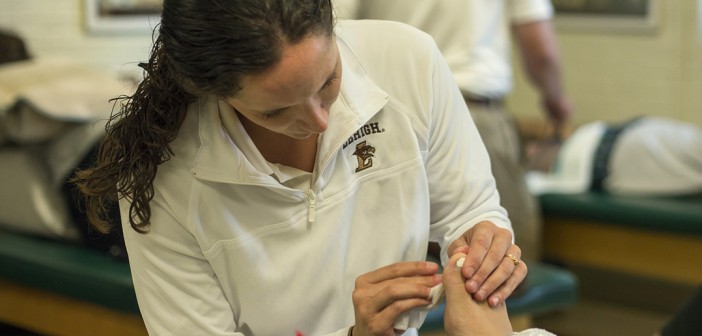
When the National Athletic Trainers’ Association was founded in 1950, there were no women in the profession. According to the association’s website, it wasn’t until 1972 that Sherry Bagagian became the first woman to sit for the certification exam.
Today, 47 percent of the association’s members are women. However, the board of certification recognizes there are still some areas of athletic training that remain gender-biased.
“There are some female head athletic trainers and some females who work with collegiate football that are head (of athletic training) of the football team, but it is still male dominated in terms of those critical positions,” said Emily Dunn, the associate director of sports medicine.
The board of certification says that although women are more prominent in the industry now, they hold just a few of the lucrative positions.
“It’s more male dominated in terms of administration roles or higher roles in the profession,” Dunn said.
Doctors who travel with the teams, called team physicians, are still a male-dominated profession.
Rachel Kennedy, the assistant director of sports medicine, said she doesn’t think she’s ever even met a female team physician. Dunn said she had only ever worked with one. Lehigh’s team physicians come through the Coordinated Health hospital network. This network is 41 percent female for athletic trainers, but females make up just 18 percent of the physicians.
According to the website, in July 2015 there were 7,629 athletic trainers working at the college or university level. Of those 7,629, Dunn, Kennedy and Catherine Rudio, a sports medicine apprentice, calculated that approximately 3,585 were females.
“The norm is probably if you’re traveling with a women’s sport, there’s a lot of female athletic trainers and vice versa,” Kennedy said. “In the three years I’ve worked with (men’s basketball), I’ve come across three women athletic trainers, maybe four. I’m not saying that it’s not normal, but you’re usually seeing more of the same gender.”
Dunn said men’s lacrosse has probably a 70-30 split of male to female athletic trainers, but men’s soccer is probably closer to a 50-50 split. With volleyball, it’s mostly females.
“It really is looking at the total differences in the sport you’re working with, the mentality of the sport, it is very dependent,” Dunn said.
Rudio said although there are some female athletic trainers working with professional sports teams, she believes it probably will never be predominately female. According to the board, there has been one female head athletic trainer in the MLB, one female assistant athletic trainer in the NFL and currently there is one female athletic trainer in the NBA. Kennedy thinks this will be the last thing to change.
At Lehigh, athletic trainers work with a team based on scheduling, personalities and other logistics, but not every school operates this way.
“Our staff looks at it more of who fits best with the team in terms of personality,” Dunn said. “There certainly are other universities where coaches preferences would be to not have a female with a male team. Their perspective is ‘I’d rather have a male with my males and a female with the females.’”
Kennedy said this feeling used to apply to many sports across college athletics, where, for example, coaches of male teams would want male trainers.
“There used to be a lot of resistance with that,” Kennedy said. “Coaches would not want females traveling with their male teams. Most of the teams here are pretty good. We’ve even had a couple programs have changes over the years, whether it’s staff changing or us changing assignments, and they’ve gone from a women’s team having a female athletic trainer to a male back to a female, and that’s not usually an issue.”
Dunn said the coaches at Lehigh are willing to work with any of the athletic trainers.
“We all work hard,” Dunn said. “We’re all willing to do the job. I’ve worked here for eight years and that has never been an issue on the docket.”
Kennedy agreed with Dunn, and said she’s never had to deal with this problem at Lehigh.
“I really have not had a lot of issues with cross coverage in terms of gender, and I know that not every athletic trainer can say that,” Kennedy added. “It’s becoming more the norm, you’re seeing a lot more women on staff than you would have in the past.”
ORIGINAL ARTICLE: